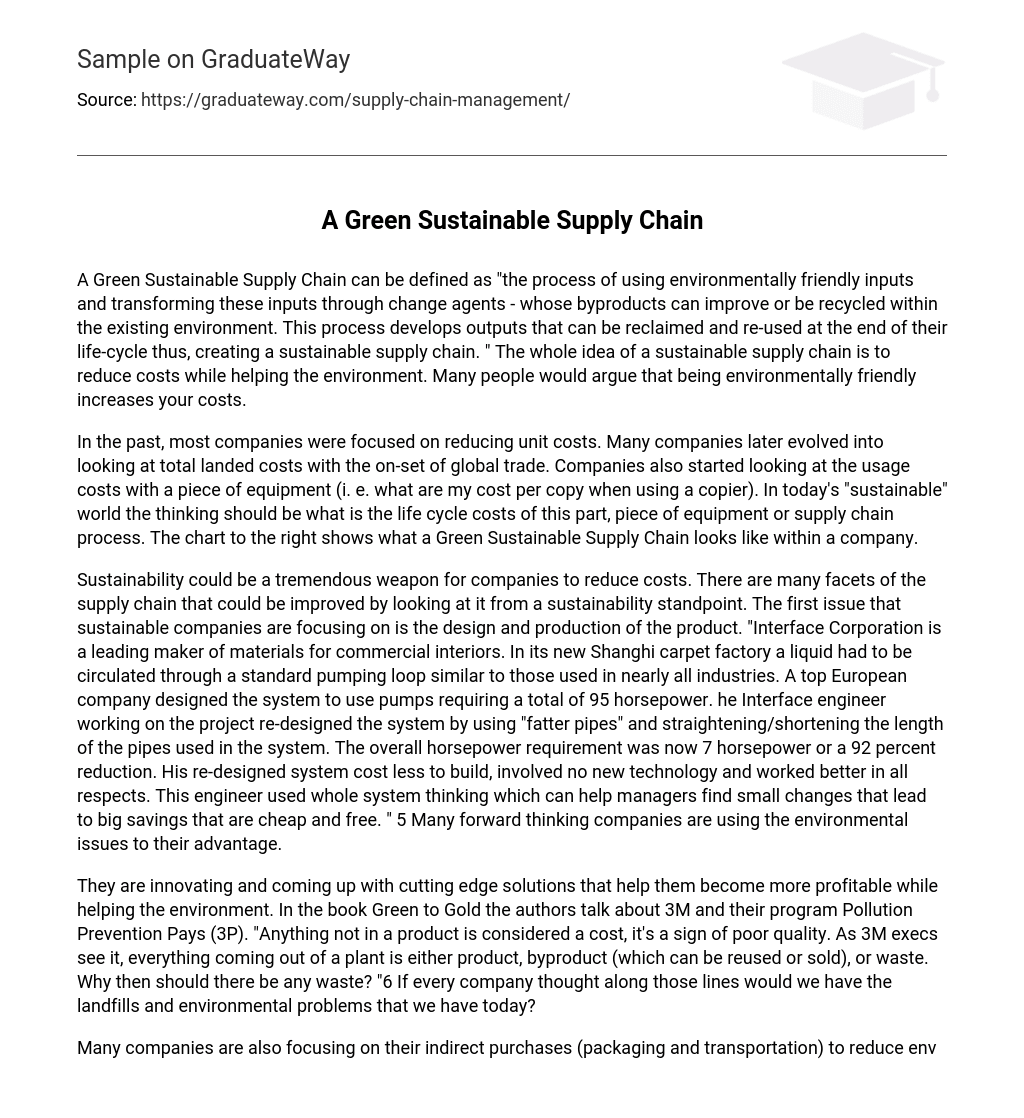A Green Sustainable Supply Chain involves using eco-friendly materials and processes to produce goods. Byproducts from these processes can be improved or recycled, creating outputs that can be reused. The goal is to create a supply chain that is environmentally friendly while also minimizing costs. There is some debate about whether being environmentally friendly leads to higher costs.
In the past, the main focus of most companies was to decrease the costs per unit. With the advent of global trade, many companies shifted their attention to considering the total costs incurred throughout the supply chain. Additionally, companies started to examine the costs associated with using specific equipment, such as determining the cost per copy when using a copier. In today’s environmentally conscious world, it is essential to evaluate the life cycle costs of various components, equipment, or supply chain processes. The illustration on the right depicts the appearance of a Green Sustainable Supply Chain within a company.
Companies can use sustainability to reduce costs in various aspects of the supply chain. The main focus for sustainable companies is on designing and producing their products. For instance, Interface Corporation, a leading provider of materials for commercial interiors, made changes to their carpet factory in Shanghi. They redesigned the pumping system by using “fatter pipes” and shorter lengths, which reduced the horsepower requirement from 95 to 7, resulting in an impressive 92% reduction. Additionally, this new system was more cost-effective, required no new technology, and had better overall performance. Embracing this comprehensive approach allows managers to identify small yet impactful changes that lead to significant savings with minimal or no cost involved. Forward-thinking companies are taking advantage of environmental issues for their own gain.
They are creating innovative and advanced solutions to improve their profitability while also benefiting the environment. In the book Green to Gold, the authors discuss 3M’s Pollution Prevention Pays (3P) program. According to 3M executives, anything that is not included in a product is considered a cost and a sign of poor quality. They view everything coming out of a plant as either a product, byproduct (which can be reused or sold), or waste. Therefore, they question why there should be any waste at all. If all companies adopted this mindset, would we still have the current issues with landfills and environmental problems?
Companies are focusing on indirect purchases like packaging and transportation to address environmental concerns. One strategy is to reduce cardboard or filler usage by using “smart packages,” benefiting the environment and saving money. Another approach is maximizing truck capacity, such as Dell increasing average load from 18,000 to 22,000 pounds and collaborating with UPS for delivery optimization. Additionally, 3M developed an innovative system with adjustable decks in trucks, reducing daily truckloads by 40 percent at a facility and resulting in $110,000 annual savings.
Currently, companies face a significant challenge with the behavior of their suppliers. They are being held accountable for the environmental problems caused by these suppliers. Unfortunately, if companies associate themselves with environmentally damaging suppliers, especially during disasters, the media tends to criticize them. This exposure can have financial implications for your company. To address this issue, many companies are conducting environmental audits or implementing codes of conduct to monitor their suppliers’ actions. Additionally, embracing sustainability practices can lead to financial gains.
GE currently has an “Ecomagination program” in place, with the goal of increasing their revenue from eco-friendly products to $20 billion by 2010. They acknowledge the potential of environmental conservation. Numerous utility companies are providing customers with environmentally generated power, charging extra for this service. Grocery stores are able to sell organic food at higher prices due to consumers’ willingness to pay more for organically grown produce. Overall, sustainability can offer a competitive edge to many businesses.
Establishing a sustainable supply chain can result in cost savings across different areas, including by-product disposal, reduction of obsolescence, scrap expenses, and resources for regulatory compliance. Certain companies have discovered new revenue streams by reusing their previously discarded by-products. Sustainability is now a competitive advantage for numerous organizations, enabling them to grow their market share within their industries. Therefore, how would your company proceed with the establishment of a sustainable supply chain?
The EPA has developed a guide called “The Lean and Green Supply Chain: A Practical Guide for Materials Managers and Supply Chain Managers to Reduce Costs and Improve Environmental Performance.” It presents a structured method for implementing a Green Supply Chain, which includes four decision-making steps. The first step is to identify environmental costs in one’s process or facility, then find opportunities that would lead to substantial cost savings and reduced environmental impact.
The third step involves calculating the benefits of the proposed alternatives, while the last step entails deciding, implementing, and monitoring the improvement solutions. The manual also provides various examples of companies that have successfully “greened” their Supply Chain. It is essential that we alter our supply chain approach to ensure future generations have access to resources for their lifetime.
Implementing a green sustainable supply chain has numerous advantages. It can enhance our company’s profitability and contribute to environmental preservation. Moreover, being environmentally conscious is not only financially beneficial but also ethically significant. To gain further insight into Green Supply Chains, make sure to attend the NA 2008 Kenote by acclaimed author Andrew Winston titled “How Smart Companies Use Environmental Strategy to Innovate, Create Value, and Build High-Performance Supply Chains.”
Footnotes
- http://www. washingtonpost. com/wp-dyn/content/article/2007/01/09/AR2007010901949_pf. tml
- http://www. ag. arizona. edu/AZWATER/awr/dec99/Feature2. htm
- Hawken, Lovins & Lovins, Natural Capitalism, (New York: Back Bay Books, 1999)
- Purchasing Magazine “China RoHS demands more from buyers” page 43 – February 15, 2007
- Hawken, Lovins & Lovins, A Road Map for Natural Capitalism, Harvard Business Review, 1999
- Esty and Winston, Green to Gold (New Haven and London, Yale University Press, 2006)
- http://ge. ecomagination. com 8. http://www. epa. gov/opptintr/library/pubs/archive/acct-archive/pubs/lean. pdf





